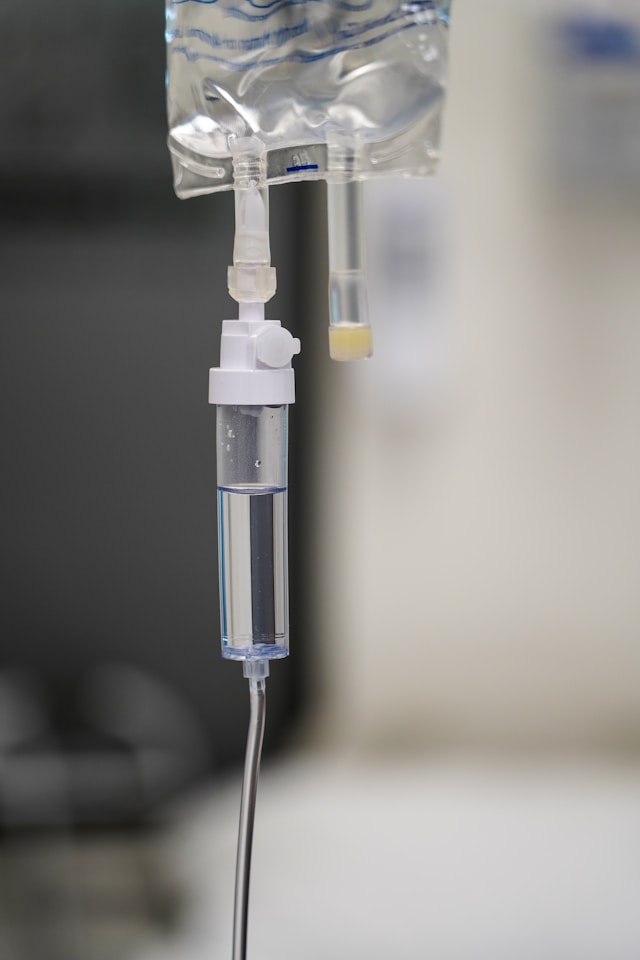
Common Side Effects of Infusion Therapy (and How They're Managed)


Dr. Chen is a board-certified immunologist with over 15 years of experience treating autoimmune and immunodeficiency disorders. She specializes in IVIG therapy and has published extensively on immune system treatments.
Medical Disclaimer
Starting any new medical treatment naturally raises questions about side effects. When it comes to infusion therapy, understanding what side effects are possible—and how your healthcare team manages them—can help you feel more prepared and less anxious. While every medication is different and every patient responds uniquely, most side effects from infusion therapy are mild, temporary, and manageable. Your infusion team has extensive experience recognizing and treating side effects to keep you as comfortable as possible throughout your treatment.
Key Highlights
- Most infusion therapy side effects are mild and temporary, including fatigue, headache, nausea, or infusion site reactions that resolve within hours to a few days.
- Serious infusion reactions are uncommon and occur in less than 5% of patients, with healthcare teams trained to recognize and treat them immediately.
- Pre-medications, adjusted infusion rates, and supportive care can prevent or minimize most side effects, making subsequent infusions more comfortable.
Understanding Side Effects vs. Infusion Reactions
Before diving into specific side effects, it's helpful to understand two different categories of effects you might experience during or after infusion therapy.
Side effects are expected responses to a medication that occur as your body processes the drug. These might include fatigue, nausea, headache, or changes in how you feel. Side effects can happen with any medication—whether taken orally, by injection, or by infusion—and are typically related to the drug's therapeutic action or how your immune system responds to it.
Infusion reactions are responses that occur specifically during or shortly after the infusion itself, often related to the rate at which medication enters your bloodstream. These can include flushing, itching, chills, or changes in blood pressure. Infusion reactions are usually manageable by slowing the infusion rate or providing additional medications.
According to the National Institutes of Health, the distinction between side effects and infusion reactions matters because they're managed differently. Understanding which you're experiencing helps your healthcare team respond appropriately.
Most Common Side Effects of Infusion Therapy
While specific side effects depend on your medication, these are the most frequently reported experiences across various infusion therapies:
Fatigue and Tiredness: One of the most common side effects patients report is feeling tired or fatigued during or after their infusion. This can range from mild drowsiness to significant exhaustion that lasts a day or two. Fatigue occurs because many infusion medications affect your immune system, and your body uses energy to process the medication. Most patients find that fatigue improves with subsequent infusions as their body adjusts.
Headache: Headaches during or after infusion are relatively common, particularly with IVIG therapy and some biologic medications. These can range from mild to moderate and typically respond well to over-the-counter pain relievers. Staying well-hydrated before, during, and after your infusion can help prevent or minimize headaches. The Mayo Clinic notes that pre-medicating with acetaminophen often reduces headache frequency and severity.
Nausea: Some patients experience mild to moderate nausea during or after their infusion. This side effect is usually temporary and can be managed with anti-nausea medications. Eating a light meal before your infusion (rather than arriving on an empty stomach or overly full) may help reduce nausea for some patients.
Infusion Site Reactions: Redness, slight swelling, or tenderness at the IV site are common and usually mild. These reactions typically resolve within a few hours to a couple of days. True irritation or inflammation at the site (called phlebitis) is less common but can occur, especially with medications that are more irritating to veins.
Muscle or Joint Aches: Some patients experience body aches, muscle soreness, or joint discomfort after infusions. This is particularly common with certain biologic medications and IVIG. These symptoms are usually mild to moderate and improve within 24-48 hours. Over-the-counter pain relievers often provide relief.
Chills or Flushing: Feeling unusually cold with shivering or experiencing warmth and facial flushing can occur during infusion. These are often infusion reactions rather than true side effects and can usually be managed by adjusting infusion speed or providing warm blankets (for chills) or slowing the infusion rate (for flushing).
Changes in Blood Pressure: Some medications can cause temporary increases or decreases in blood pressure during infusion. Your healthcare team monitors your vital signs throughout treatment and can respond quickly to any significant changes.
Allergic-Type Reactions: Mild allergic responses like itching, hives, or skin rash can occur. These are usually managed easily with antihistamines and don't necessarily mean you can't continue the medication. True severe allergic reactions are rare.
Side Effects Specific to Common Infusion Types
Different medications can cause distinct side effects beyond the general ones listed above:
Biologic Infusions (Remicade, Entyvio, Orencia, etc.): May cause increased risk of infections over time due to immune system suppression. Patients might experience upper respiratory infections, urinary tract infections, or other infections more frequently. Your healthcare provider will monitor you for signs of infection.
IVIG Therapy: Aseptic meningitis (headache with stiff neck) is a rare but known complication. More commonly, patients experience headaches that can be significant but are usually preventable with slower infusion rates and good hydration.
Iron Infusions: Some patients experience a metallic taste during infusion or notice darkening of their stool in the days following treatment (this is normal and not concerning). Rarely, iron infusions can cause joint pain or muscle aches that last a few days.
Multiple Sclerosis Medications (Ocrevus, Tysabri): Infusion reactions during the first dose are more common than with subsequent doses. Some MS medications can increase infection risk or affect white blood cell counts, requiring regular monitoring.
Monoclonal Antibodies for Migraines (Vyepti): Generally well-tolerated with fewer side effects than many other infusion therapies. Some patients report nasal congestion or nasopharyngitis (cold-like symptoms).
How Healthcare Teams Prevent and Manage Side Effects
Your infusion team uses multiple strategies to minimize side effects and keep you comfortable:
Pre-Medications: Many infusion centers routinely give medications before your infusion to prevent side effects. Common pre-medications include acetaminophen (to reduce fever, headache, and body aches), antihistamines like diphenhydramine or cetirizine (to prevent allergic reactions and itching), and sometimes corticosteroids for patients at higher risk of reactions. According to the Infusion Nurses Society, pre-medication protocols significantly reduce the incidence and severity of infusion reactions.
Adjusted Infusion Rates: If you experience side effects during your infusion, your nurse can slow the rate at which medication is delivered. A slower rate often eliminates or reduces uncomfortable symptoms, though it extends your treatment time.
Hydration: Ensuring you're well-hydrated before, during, and after your infusion helps your body process the medication and can reduce side effects like headaches and nausea. Many infusion centers provide IV fluids before or after your medication if needed.
Comfortable Environment: Temperature control, comfortable seating, and a calm atmosphere help your body stay relaxed during treatment, which can minimize stress-related side effects.
Continuous Monitoring: Regular vital sign checks and frequent nurse assessments allow early identification of any concerning symptoms, enabling quick intervention before side effects become severe.
Symptom Management Medications: If you develop side effects despite preventive measures, your healthcare team can provide medications to address specific symptoms—anti-nausea drugs, pain relievers, or medications to manage blood pressure changes.
Protocol Modifications: For subsequent infusions, your healthcare provider can adjust your protocol based on how you responded to previous treatments. This might include adding pre-medications, changing infusion speed, or scheduling your infusions at different times of day.
When to Contact Your Healthcare Provider
While most side effects are mild and expected, certain symptoms warrant contacting your healthcare provider:
During Your Infusion (tell your nurse immediately):
- Difficulty breathing or shortness of breath
- Chest pain or tightness
- Severe headache that comes on suddenly
- Facial swelling or throat tightness
- Severe itching or rapidly spreading rash
- Dizziness or feeling faint
- Significant pain at the IV site
- Any symptom that feels severe or frightening
After You Leave the Infusion Center (contact your healthcare provider):
- Fever above 100.4°F (38°C)
- Symptoms that worsen rather than improve over 24-48 hours
- Signs of infection (increased warmth, redness, swelling, or pus at IV site)
- Severe headache unrelieved by over-the-counter medications
- Difficulty breathing or chest discomfort
- Persistent nausea or vomiting
- Any new symptom that concerns you
The Cleveland Clinic emphasizes that while serious reactions are uncommon, patients should never hesitate to seek medical attention if they're concerned about any symptom.
Side Effects Often Improve Over Time
One reassuring aspect of infusion therapy is that many patients find side effects decrease with subsequent treatments. Your body often adjusts to the medication over time, making later infusions more comfortable than your first few.
First infusions are given more cautiously with slower rates and closer monitoring, which can paradoxically make them feel more uncomfortable for some patients. As your healthcare team confirms you tolerate the medication well, they may adjust protocols to make future infusions smoother.
Many patients report that by their third or fourth infusion, they experience significantly fewer side effects and have learned what strategies help them feel best—whether that's staying extra hydrated, eating a specific meal beforehand, or planning to rest the evening after treatment.
Tips to Minimize Side Effects
Based on patient experiences and clinical guidance, these strategies may help reduce side effects:
Before Your Infusion:
- Stay well-hydrated in the 24 hours before treatment
- Eat a balanced meal 1-2 hours before your appointment
- Get adequate sleep the night before
- Take any pre-medications as prescribed
- Avoid alcohol for 24 hours before treatment
During Your Infusion:
- Continue sipping water throughout your treatment
- Stay warm with blankets if you tend to get chills
- Practice relaxation techniques or distraction (reading, videos)
- Communicate any discomfort to your nurse early
- Don't hesitate to ask for symptom-relief medications if needed
After Your Infusion:
- Plan for rest the remainder of the day if you experience fatigue
- Continue drinking plenty of fluids
- Avoid strenuous activity for 24 hours
- Take over-the-counter pain relievers as needed for headache or body aches
- Monitor for any worsening or concerning symptoms
- Get good sleep to help your body recover
Long-Term Side Effects and Monitoring
Some infusion medications can have long-term effects that require ongoing monitoring, though serious long-term complications are relatively uncommon:
Increased Infection Risk: Many biologic medications and immunoglobulin therapies affect your immune system, which can increase susceptibility to infections. Your healthcare provider will educate you about infection prevention and may recommend vaccines or prophylactic medications.
Liver Function Changes: Some medications can affect liver enzymes. Your doctor will monitor this with periodic blood tests.
Changes in Blood Cell Counts: Certain infusion therapies can affect white blood cells, red blood cells, or platelets. Regular blood work helps your healthcare team monitor these levels.
Infusion Reactions May Develop: While uncommon, some patients develop reactions to medications they previously tolerated well. This is why continued monitoring remains important even after you've had many successful infusions.
Regular follow-up appointments and laboratory monitoring help your healthcare team identify any long-term effects early and make adjustments to keep you safe.
Frequently Asked Questions
What are the most common side effects of infusion therapy?
The most common side effects of infusion therapy include fatigue, headache, nausea, and mild reactions at the IV site. Most patients experience mild, temporary symptoms that resolve within hours to a couple of days. Serious side effects are uncommon, occurring in less than 5% of patients, and your healthcare team monitors you closely to manage any reactions that develop.
How long do infusion side effects last?
Most infusion side effects last anywhere from a few hours to 1-2 days after treatment. Fatigue and mild body aches typically resolve within 24-48 hours. Some patients feel completely normal within hours of finishing their infusion, while others need a day or two to feel back to baseline. Side effects generally become less noticeable with subsequent infusions as your body adjusts to the medication.
Can you have an allergic reaction to infusion therapy?
Yes, allergic reactions to infusion therapy can occur, though true severe allergic reactions are uncommon. Mild allergic responses like itching, hives, or flushing occur more frequently and are usually managed easily with antihistamines or by slowing the infusion rate. Severe allergic reactions (anaphylaxis) are rare but are why you're monitored closely throughout your infusion and for a period afterward.
What helps with fatigue after infusions?
Rest, adequate hydration, and allowing yourself time to recover help manage post-infusion fatigue. Many patients find that planning light activities for the day of and day after their infusion helps them feel better. Some patients benefit from gentle exercise once they feel up to it, while others need complete rest. Fatigue often improves with subsequent infusions as your body adjusts to treatment.
Are side effects worse with the first infusion?
Side effects are often more noticeable during first infusions because your body is encountering the medication for the first time and because the infusion is given more slowly with closer monitoring. Many patients find that subsequent infusions are more comfortable as their body adjusts, protocols are optimized based on their response, and they learn what strategies help them feel best during and after treatment.
Side Effects Are Manageable and Temporary
While side effects are a reality of infusion therapy, they're typically mild, temporary, and well-managed by experienced healthcare teams. The symptom relief and disease control that infusion therapy provides generally far outweighs the temporary discomfort of side effects for most patients.
Open communication with your infusion team ensures that any side effects you experience are addressed promptly, and protocols can be adjusted to make your treatment as comfortable as possible.
Ready to find an infusion center with experienced staff who prioritize patient comfort? Explore infusion centers near you to begin treatment with a team dedicated to managing your care.
Medical Disclaimer: This content is for educational purposes only and is not a substitute for professional medical advice, diagnosis, or treatment. Always consult your healthcare provider with questions about your medical condition or treatment options.
Article Statistics


Table of Contents
Article Statistics










